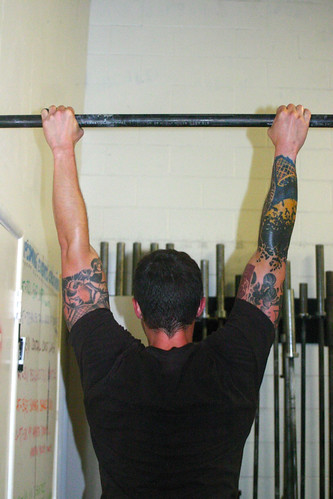The Power of Fermentation!
Sunday, September 30, 2012
Warm-up/Mobility:
Skip rope 5 minutes
DROM
15 GHD Sit-ups
15 Back extensions
Spend 20 minutes and work on a weakness. This could be muscle-ups, double unders, butterfly pull-ups, handstand walking, etc.
Workout:
Four rounds for time of:
15 foot rope climb, 3 ascents
30 Push ups
30 Sit-ups
18 minute time cap!
Cool down:
Row 500 easy
Quad on wall, 1 minute each
Cobra, 30 seconds
 Robert.
Robert.
I have been eating with a Paleo lifestyle approach for a little over a year and a half now. I have come to a point where I would like to step up to another level, now that I feel like I have the basics down to eating with a whole foods approach. My goal is to obtain everything I need from food and a healthy lifestyle. For me personally that means adapting/continuing the following habits and changes: by eating real, unprocessed foods that can be grown, hunted, or gathered. Eating animals, wild fish, vegetables, nuts, seeds,and little fruit. Eating plenty of healthy fats from pastured animals, coconut, avocado, olives, and cold-pressed oils. Drinking plenty of water. Incorporating traditional, nutrient-dense foods: fermented vegetables, organ meats, and homemade bonebroths. Also providing my body with adequate sleep, sun exposure, exercise, grounding, and stress reducing techniques.
With the start of this year, I have been able to adapt some of these new additions to my already healthy lifestyle. Such as sun exposure on a daily basis, grounding a few times a week at the beach or lawn to read, meditation, therapy, adequate sleep, and fermented foods. I still have many steps to take to achieve all of these lifestyle changes but I am ok with slowly doing so, as I learn more I will adapt and make changes as I go. For today, I would like to touch on the subject of the addition of fermented foods into the diet: what fermentation is, its benefits, and how to make homemade sauerkraut.
Fermented foods are foods that have been through a process of lactofermentation where natural bacteria feed on the sugar and starch in the food making lactic acid. This process preserves the food, while creating beneficial enzymes, b-vitamins, and different strains of probiotics. It has even been shown to break down the food to a more digestible form. The combination of the break down of food and probiotics created during the fermentation process is why this food enhances the digestive function.
Two important functions of the gut are: to prevent foreign substances from entering the body and protect from infection. An unhealthy gut (leaky and low good gut bacteria) can contribute to a wide range of diseases. By eating a paleo diet and incorporating a probiotic type food like sauerkraut will promote, a healthy mucosal lining and beneficial bacteria in the gut! The combo affect of these two factors are powerful.
According to Chris Kresser:
“The gut flora promotes normal gastrointestinal function, provides protection from infection, regulates metabolism and comprises more than 75% of our immune system. Disregulated gut flora has been linked to diseases ranging from autism and depression to autoimmune conditions like Hashimoto’s, inflammatory bowel disease and type 1 diabetes.”
We get cabbage in the produce delivery almost every week and we all have sea salt in the house meaning we have what we need to make this superfood! But if you are not up for making it, which I totally understand, some good brands to look for are Farmhouse Culture brand and Bubbies brand. When buying you want to go to the cold section. Also when eating you should try to eat it cold, but if you choose to heat up don’t heat above 100-120 degrees because then you won’t be getting the probiotic effect. Other fermented foods are: kimchi, kombucha, kefir, yogurt, etc.. When incorporating sauerkraut into your diet you should try to shoot for 1/4 cup a day preferably in the AM.
In the last few months, I have been eating Bubbies brand kraut that i purchase from rainbow acres. Today I am going to attempt to make homemade sauerkraut with the recipe below, adapted from “Practical Paleo” by Diane Sanfilippo. I will report back in a couple weeks on how it goes!
Roasted Jalapeño & Garlic Raw Sauerkraut
“You will need two, 32 ounce glass mason jars for the finished product. “
Prep time: 30 minutes
Fermenting time: 2-3 weeks
Yields: approximately 2, 32-ounce jars
Ingredients:
1 large head of green cabbage, sliced into thin strips (set large out layers aside)
1-2 tbs sea salt
2 large carrots, shredded
2-4 cloves of garlic finely sliced (2 if large, 4 if smaller)
1-2 jalapeño peppers, roasted
Black pepper to taste
Process:
Place 1/3 of your sliced cabbage into a large bowl and sprinkle 1 tbs of salt over it. Using hands, squeeze the cabbage until water begins to come out of it.
Repeat this process, adding the remaining cabbage and salt 1/3 at a time to the bowl. This will take time and elbow grease, so be ready to get your hands involved.
Add the shredded carrots, garlic, jalapeños, and black pepper to the mixture and combine with your hands.
Fill two 32-ounce mason jars evenly, pressing the mixture down so that water releases and raises above the line of the vegetables with 2 inches of air-space remaining at the top.
Wedge the large outer leaves you had set aside into the top of the jars so that the mixture is pressed below and the water level raises above the leaf. A shot glass, or ceramic/glass pinch-bowl serves nicely as additional weight to keep the mixture held securely down.
Set the filled jars aside in a flat pan or dish with an edge so at if there is any spillover you keep it contained.
Store the jars in a secure, cool, darkish place where they will not be disturbed.
Check on your sauerkraut every day o two to make sure that the water level has remained above the vegetables and that no vegetables are coming into contact with air. The fermentation process happens under water, so if you see anything touching the surface, use a clean spoon to remove it. You may also see some growth or mold form around the top of the liquid–this is normal, but it’s best to remove it when you see it. If you need to add liquid to the jars, add some fresh water to make sure that everything is below the water line. The weights should help a lot with this.
Allow the sauerkraut to sit for at least 2 weeks and taste it periodically.
Once the sauerkraut tastes as you like it, place the lid on the jar and store in the refrigerator. It will last for several months while refrigerator and will not continue to ferment further.
ENJOY : )
~Jess~















